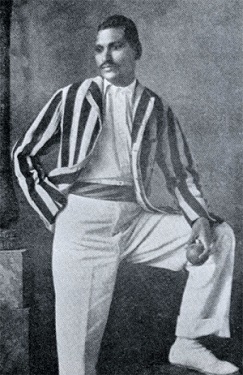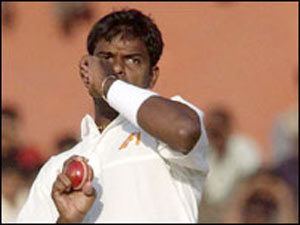Scheduled caste players in Indian cricket teams

This page became necessary because the SC contribution |
This page is being expanded with short profiles of great SC international (and later, domestic and ST) players.
Contents |
SC players who have represented India
How many scheduled caste cricketers have represented India internationally?
a) Dalit Nation – The Only Authentic Voice of Dalits writes, ‘We had only few dalit cricketers in all these years Balwanth Paloo ( the cricketer who Inspired Babasaheb), Eknath Solkar and Vinod Kambli.’
b) Mr Rajesh Krishna writes, ‘As of my knowledge only two dalits have so far represented India in his [sic] 75 years of history (Balwanth Paloo from Karnataka and Vinod Kambli).’
By ‘Balwanth Paloo’ perhaps Mr Rajesh Krishna, Dalit Nation and countless websites--Indian as well as foreign--that have simply copy-pasted their remarks mean the legendary Babaji Palwankar Baloo of Dharwad, Karnataka. Wikipedia’s List of India Test cricketers mentions no one called Balwanth (or Balwant) Paloo.
c) Mr Anand writes on Ambedkar.org, ‘Independence [sic] India has produced not one Dalit cricketer. (Vinod Ganpat Kambli and Doddanarasiah Ganesh, both with short-lived careers, are being talked about as the only post-1947 Dalit cricketers but Kanadiga friends inform me that Ganesh could be a backward caste ‘gowda’ and Kambli, it appears, is from a fisherman caste and technically not Scheduled Caste.)’ [Emphasis added]
In view of Mr Anand’s analysis, that only leaves Eknath Solkar from the Dalit Nation's list. Elsewhere, Indpaedia has presented the results of its Google searches about the Solkar caste. Unless fresh evidence comes up, we have no option but to accept SportTaco’s assertion: ‘Solkar was of high-caste origin.’
d) Indpaedia, as will become obvious in the next few paragraphs, has NO position in this debate except to investigate into the veracity of every ‘fact’ proffered, every assertion made. During their Google searches into the caste and domicile of every test cricketer since independence, Indpaedia’s volunteers chanced upon facts that give some totally fresh and hitherto undiscovered inputs into the history of the scheduled caste contribution to Indian cricket.
Google searches reveal nothing about the castes of a very large number of cricketers. An equally large number of surnames are titles rather than caste-names. Indpaedia’s volunteers believe that reader-sourced information about cricketers' castes not revealed by Google might lead to at least two or three more scheduled caste heroes in test cricket.
e) Karsan Ghavri, the discovery: In 2004 The Times of India mentioned that ‘The BJP want[ed] Ghavri to fight from Patan, a reserved seat.’
However, before making an assertion that neither Mr Anand nor Mr Rajesh Krishna nor DalitNation were aware of, Indpaedia crosschecked, and with several sites.
Indeed, the site Elections.in indicates that from 1967 to early 2009 (both inclusive) Patan was a seat reserved for the SC category. If the two items are correct, and they do seem to bear each other out, then Karsan Ghavri could probably be the tallest post-1947 test cricketer from a scheduled caste (since Mr Anand has doubts about Mr Kambli’s fisherman caste being scheduled). In any case, even in North India ‘Ghavri’ is by no means an ‘upper caste’ (as falsely asserted by Mr Anand).
Further support for this discovery comes from the site Glimpses-Of-Hindu-Genius, which lists ‘Eknath Solkar, Vinod Kambli Karsan Ghavri’ under ‘Our Dalit Heritage.’
f) Discovery 2: Would Mr Anand, Mr Rajesh Krishna and DalitNation include the Scheduled Tribes in the Dalit category? If yes, then Lalchand Rajput, never mind his surname, is a bona fide member of the Goaar community. (As discussed elsewhere in Indpaedia, he could even be considered a scheduled caste, at least in his own state, which is what matters.)
Rajput, Lal Chand: Sport Taco asserts that he is from a scheduled tribe. Banjara Times describes him as the ‘Goaar Cricket Star Lal Chand Rajput.’ Goaar is the umbrella caste of Banjara, Bazigar, Lambani and Lambada. Wikipedia informs us that ‘In some states of India, [the Banjaras] are considered as Scheduled Caste while in other states they are categorized as Scheduled Tribe. In the state Rajasthan, they are Other Backward Classes (OBC) category. In [Lalchand’s] Karnataka, they are categorised as Scheduled Caste since 1977.’ From the same Banjara Times it was seen that they wanted to be categorised as a Scheduled Tribe. See Lalchand Rajput
Career highlights
This section is being updated
Indpaedia is only certain that Palwankar Baloo, indeed the Palwankar brothers, belonged to a scheduled caste and Lalchand Rajput does so in his state. Brief biographies of all cricketing heroes who have represented India internationally have been given below if at least one leading Dalit website/ writer has indicated that he is or might be SC.
There is good evidence that Karsan Ghavri might be SC and Bhuvneshwar Kumar a Mavi Gurjar. The Gujjars are scheduled tribes in some states.
Doddanarasiah Ganesh
B: June 30, 1973. Being the most successful bowler for Karnataka in 1998-1999 earned him the Indian cap. <>In Tests against South Africa and West Indies he took five wickets at an average of 57.40. <> In his sole ODI, against Zimbabwe in 1996-97, he took one wicket and gave away 20 runs in five overs.
Karsan Devjibhai Ghavri
B: February 28, 1951. One of India’s best all-rounders and medium pace bowlers. A late-order batsman who often rescued the team. <>1968-69, vs. Australia: Showed early promise during Indian schools team's tour. <> 1977-78, vs. Australia: Took seven wickets at Adelaide. <> 1978-79, against West Indies: Took 27 wickets. <> Highest Test score (86) and record eighth-wicket stand (127) with Syed Kirmani: against Australia.
Vinod Ganpat Kambli
B: January 18, 1972. <>Kambli and Sachin Tendulkar created a world-record unbroken 664-run partnership in a school match. <> In Ranji Trophy Kambli hit the first ball bowled to him for six. <> Scored two centuries and two double-centuries in his first seven Tests. <> Derek Pringle wrote in The Telegraph, UK, ‘After seven Tests, Kambli had scored 773 runs at an average of 113.2... Only cricketing icons Don Bradman, Sunil Gavaskar, Everton Weekes, George Headley and Frank Worrell have scored more… But you can…get sucked into the fame game, something Kambli, with his sudden passion for bling and booze, did rather too enthusiastically for those running Indian cricket.’
Indpaedia believes that given Kambli’s career average of 54.2 runs, he could have been allowed more than one chance to reform his attitudinal lapses instead of cutting his career short.
Bhuvneshwar Kumar (Singh)
Lalchand Sitaram Rajput
B: December 18, 1961.
See Lalchand Rajput
Eknath Dhondu Solkar
Sanjay Bangar
He belongs to a scheduled caste, according to Chamaar Today
Career: See Sanjay Bangar
Kedar Jadhav
He belongs to a scheduled caste according to Chamaar Today
Career: See Kedar Jadhav
A brief discussion on the castes of players
Chamaar: The legendary Palwankar Baloo (and his slightly less famous cricketing brothers) belonged to the Chamaar caste and were from Dharwad, Karnataka.
Goaar/ Banjara: Sport Taco indicates that Lal Chand Rajput is from a scheduled tribe. Banjara Times describes him as the ‘Goaar Cricket Star Lal Chand Rajput.’ Goaar is the umbrella caste of Banjara, Bazigar, Lambani and Lambada. Wikipedia informs us that ‘In some states of India, [the Banjaras] are considered as Scheduled Caste while in other states they are categorized as Scheduled Tribe. In the state Rajasthan, they are Other Backward Classes (OBC) category. In [Lalchand’s] Karnataka, they are categorised as Scheduled Caste since 1977.’ From the same Banjara Times it was seen that they wanted to be categorised as a Scheduled Tribe.
Ghavri: Karsan Devjibhai was a Gujarati. Google yields nothing about Gujarati Ghavris but in north India Gavri, Gawri, Ghawri and Ghavri are Aroras, an intermediate caste. Three sites indicate that Karsan belongs to a scheduled caste.
Gowda is a title given to Karnataka village headmen. Generally people from the following communities use this surname: Lingayats, Vokkaliga, Kurubas, Soligas, and Kadu Kuruba tribals. Mr S Anand suggests that Doddanarasiah Ganesh is a Gowda.
Gurjar: Countless sites indicate that Bhuvneshwar Kumar is a Gurjar/ Gujjar. These include: Ashok Harsana, Bhuvneshwar-Kumar and Gujjar Ki Yaari.
Are the Gujjars SC? No. In J&K they have been declared ST and are demanding that status elsewhere as well. They are OBC almost everywhere. Therefore, Bhuvneshwar Kumar’s inclusion in this list is tentative.
Kambli: Vinod Kambli’s caste is not clear-cut. As Mr S. Anand points out, Mr Kambli could be from a fisherman caste and technically not a Scheduled Caste.
Solkar: i) SportTaco writes: ‘Solkar was of high-caste origin, but he came from a lower-class background. He learnt all his cricket at the Hindu Gymkhana, where his father happened to be the groundsman.’ ii)When one Shishti Solkar sought to be classified as a scheduled caste, the Delhi High Court pointed out that Solkar’s scheduled caste ‘certificate has been obtained fraudulently and cannot be believed.’ IndianKanoon iii) On the other hand, some people with the surname Solkar are scheduled castes at least among the Telugu people: (SimplyMarry), if not in Maharashtra.
Domestic cricket
See also
Scheduled castes in Indian cricket teams
Scheduled caste talents in Indian cinema
...and countless British-era articles about individual castes and tribes. Just click 'Communities' in the 'Categories' box below this article or enter the name of the caste or tribe in the Search box at the top of this page





